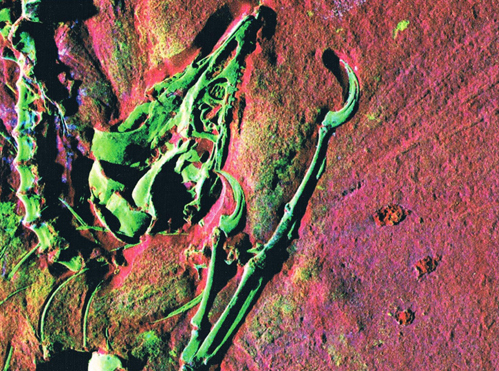Manchester University Leads the Way With Mapping Elements (Dinosaur Chemical Ghosts)
Studying fossils has changed radically over the last two decades. More and more tools are being added to the palaeontologist’s armoury, many of these tools are drawn from a variety of other scientific disciplines, engineering, materials science and medicine for example. Manchester University has been pioneering the mapping of elements including metals in fossil material. Once an understanding of a fossil in terms of the elements preserved has been achieved, researchers can begin to piece together clues about the biology of the organism and the burial history.
Dinosaur Chemical Ghosts
Using a sophisticated piece of technology (synchrotron-based X-ray imaging), scientists can explore the composition of scales, teeth, skin and feathers from long extinct creatures. Elements such as zinc (Zn) and Calcium (Ca) can be plotted on the fossil, providing details on features that would not be visible under normal light or ultra-violet lighting conditions.
A False Colour SRS-XRF map of an Archaeopteryx Fossil
Picture credit: Manchester University
The picture above shows a close up of the skull, cervical vertebrae (neck bones) ribs and the wings of Archaeopteryx (Archaeopteryx lithographica).
Key
red = Ca (calcium, the matrix is limestone, hence, high levels of calcium surrounds the fossil)
green – Zn (zinc)
blue = Mn (manganese)
The brighter and more intense the colour the higher concentration of that element.
Mapping Elements in Fossils
Blue flecks of colour on the surface of the fossil are the result or the presence of tiny precipitates of manganese minerals, which has probably been deposited by ground water. There is some zinc associated with mineral precipitates too, but virtually all of the zinc in this image is associated with the fossil bone material. This suggests that zinc was present in large quantities in the original bone (as found in many types of organism today). The zinc has been locked within the bones for over 150 million years, as Archaeopteryx (A. lithographica) lived during the Late Jurassic.
It is the application of new technologies that is opening up a whole world of new possibilities when it comes to investigating creatures that lived in the past.
Back in January, 2015 Everything Dinosaur team members made a number of predictions as to what might happen in the palaeontology over the next twelve months. One of our “palaeontology predictions” was that there would be more research undertaken into biometals preserved as fossils, there would be more work on the metallome.
A metallome is the presence of metallic elements in relation to organic matter. From analysis of this data, scientists will be able to learn more about the type of biological processes that once were carried out by long dead organisms.
To read more about Everything Dinosaur’s palaeontology predictions for 2015: Palaeontology and Fossil Predictions for the Next Twelve Months (2015).
For an article published in May 2014 that explains in a little more detail some of the research currently being undertaken into biometals and their presence in the fossil record: Palaeontology Enters the Metal Age.
Visit Everything Dinosaur’s award-winning website: Everything Dinosaur.







Leave A Comment